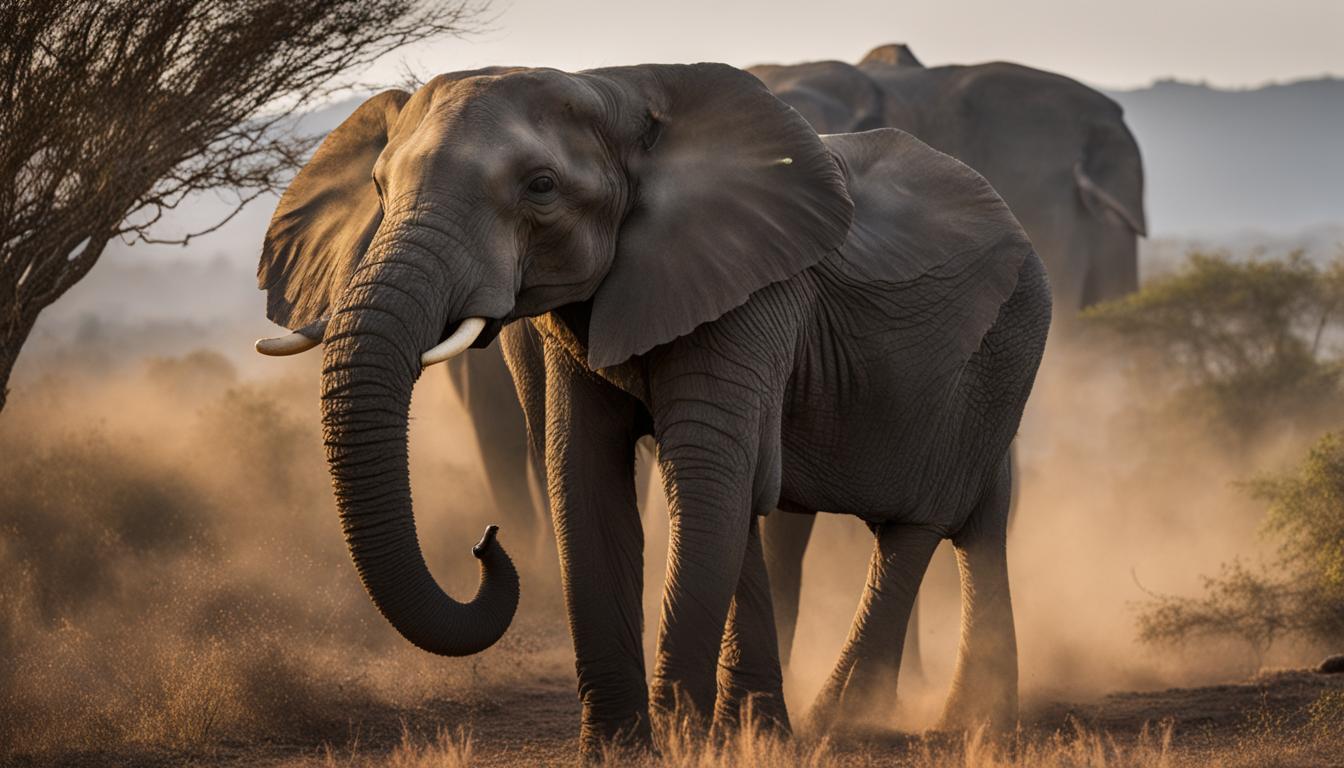Elephants are fascinating creatures with a highly developed communication system. They utilize various methods, including vocalizations, to convey information and interact with each other. Understanding elephant vocalizations and their role in communication is key to comprehending their intricate world.
When it comes to expressing themselves, elephants have a vast repertoire of sounds. Their vocalizations range from rumbles to snorts, barks, roars, cries, and idiosyncratic sounds. These sounds are used to convey information about their physiological and emotional state, as well as their intentions and desires. One of the most commonly used sounds is the low-frequency “rumble,” which can be made with the mouth open or through the trunk.
Elephants also communicate through acoustic, chemical, visual, and tactile means. They emit trumpet sounds through their trunks, which are loud and shrill calls often associated with elephants. Additionally, they utilize infrasound, low-frequency sounds below the level of human hearing, for long-distance communication and warning of predators. Visual and tactile signals, such as postures, displays, touching, and caressing, are also used by elephants to convey messages and maintain social bonds.
By combining these various forms of communication, elephants effectively convey complex information. Understanding and interpreting their vocalizations provide valuable insights into their unique communication system and helps us appreciate the intricacy of their world.
Acoustic Communication in Elephants
Elephants employ a diverse range of sounds to communicate, with each sound serving a specific purpose. Rumbles, snorts, barks, roars, cries, and idiosyncratic sounds are just a few examples of the different types of vocalizations elephants can produce. The most commonly used vocalization is the rumble, which can be emitted with the mouth open or through the trunk. These rumbling sounds have a unique characteristic – they are produced at very low frequencies, often vibrating around 12 Hz for males. This low-frequency range is below the human hearing threshold but allows the sound to travel long distances, making it ideal for long-distance communication, mating rituals, and predator warnings.
Elephants are not limited to producing powerful, low-frequency sounds. They also possess the ability to create more gentle and subtle vocalizations. This wide range of vocal capabilities allows elephants to express a variety of emotions, intentions, and desires. It is fascinating to observe how elephants can convey information through these different vocalizations, and it highlights the complexity of their communication system.
Understanding the various types of elephant sounds and their meanings is crucial for comprehending the social dynamics and behaviors of these magnificent creatures. By deciphering the nuances of their vocalizations, researchers and conservationists can gain valuable insights into elephant communication and contribute to their overall well-being and conservation efforts.
To provide a comprehensive overview of the different types of elephant vocalizations, let’s explore a table displaying some examples:
| Vocalization | Description |
|---|---|
| Rumble | A low-frequency vocalization used for long-distance communication, mating rituals, and warning of predators. |
| Snort | A sharp, forceful expulsion of air through the trunk, often signaling aggression or excitement. |
| Bark | A short, loud vocalization with a sharp tone, typically used in response to a perceived threat or disturbance. |
| Roar | A deep, powerful vocalization associated with dominance and territorial displays. |
| Cry | A high-pitched vocalization expressing distress or pain, often emitted by young elephants. |
| Idiosyncratic sounds | Individual-specific vocalizations that vary between elephants and may serve to identify or locate each other. |
Understanding the diversity and intricacies of elephant vocalizations enhances our ability to appreciate their complex communication system. By acknowledging and respecting the rich auditory world of elephants, we can further promote their well-being and conservation.
Chemical Communication in Elephants
Aside from their vocalizations, elephants also rely on chemical communication to convey messages and communicate with one another. This form of communication involves the use of secretions emitted by elephants as well as their incredibly acute sense of smell.
One notable form of chemical communication in elephants is the emission of a trumpet sound through their trunk. This loud and shrill call is often associated with elephants and can serve as a way to communicate warning signals or express distress.
In addition to trumpet sounds, elephants also utilize infrasound communication. Infrasound refers to low-frequency sounds that are below the level of human hearing. These powerful, distant-traveling sounds enable elephants to send messages and warnings over long distances, helping them to locate distant family members and alert others of potential predators.
By combining vocalizations, chemical signals, and other communication methods, elephants have developed a sophisticated system of communication that allows them to effectively interact with one another and convey important information.

Table: Types of Elephant Communication
| Communication Method | Description |
|---|---|
| Vocalizations | Includes a wide range of sounds such as rumbles, snorts, barks, roars, cries, and idiosyncratic sounds. |
| Chemical Signals | Utilizes secretions emitted by elephants and their acute sense of smell to communicate messages and convey information. |
| Visual Displays | Involves postures, displays, and the use of sight to communicate with other elephants. |
| Tactile Interactions | Includes touching, caressing, and smelling using their trunks to convey messages of interest, fear, and grief. |
Visual and Tactile Communication in Elephants
Elephants possess a highly evolved system of communication that extends beyond vocalizations. Visual and tactile signals play a crucial role in conveying messages and maintaining social bonds within their clan-based society. Through a combination of postures, displays, and their acute sense of sight, elephants communicate visually, providing valuable insights into their social dynamics and intentions.
In addition to their visual communication, elephants utilize their trunks for tactile interactions. They use their trunks to touch, caress, and smell, facilitating communication with other elephants. Tactile sensations serve as a means of expressing interest, fear, or grief, allowing elephants to convey their emotions and intentions through gentle touches or more forceful interactions.
Furthermore, elephants’ highly developed sense of smell enhances their ability to understand their environment and communicate effectively. Their trunks enable them to sense various odors, both on the ground and in the air. Elephants use their acute sense of smell to communicate their receptive state for mating, locate distant family members, and explore their surroundings.
Understanding Elephant Vocalizations through Visual and Tactile Signals
By combining their vocalizations with visual and tactile cues, elephants create a holistic communication system. The interpretation of elephant vocalizations is enhanced when considering their visual and tactile behaviors. For example, a low-frequency rumble accompanied by specific postures and trunk movements may indicate a dominant or submissive interaction between elephants.
Observing elephants’ visual and tactile communication can provide valuable insights into their social structures, relationships, and emotional states. Researchers and conservationists continue to study and unravel the complexities of elephant communication to better understand these magnificent creatures and promote their well-being in the wild.
| Visual Communication | Tactile Communication | Sense of Smell |
|---|---|---|
| Postures and displays | Touching, caressing, and smelling with their trunks | Sensing odors on the ground and in the air |
| Expressions of intentions and emotions | Conveying interest, fear, and grief | Communication of receptive state for mating |
| Enhances understanding of vocalizations | Facilitating social bonds and interactions | Locating distant family members |
Conclusion
Elephant vocalizations are incredibly diverse and complex, encompassing a wide range of sounds and signals that serve various purposes in their communication. Through their well-developed system of acoustic, chemical, visual, and tactile communication, elephants effectively convey information about their physiological state, emotions, intentions, and desires.
One of the most fascinating aspects of elephant communication is their use of low-frequency vocalizations. These include the famous rumbles and infrasound calls, which allow elephants to communicate over long distances and maintain social bonds within their clan-based society. The use of low-frequency vocalizations is crucial in their ability to warn of predators, participate in mating rituals, and establish their presence in the vast landscapes they inhabit.
Understanding and interpreting elephant vocalizations provides invaluable insights into their unique communication system. It helps us appreciate the intricacy of their world and deepens our understanding of these majestic creatures. By studying their low-frequency vocalizations and the combination of various communication methods, we gain a deeper understanding of their behavior, social dynamics, and the challenges they face in their natural habitats.
So next time you have the opportunity to encounter these magnificent creatures, pay attention to their vocalizations and the messages they convey. It’s an incredible window into their world, allowing us to connect with them on a deeper level and truly appreciate the beauty and intelligence of elephant communication.
Does the Global Trade in Elephant Ivory Affect Elephant Communication Patterns?
The global trade in elephant ivory status has a significant impact on the communication patterns of elephants. Due to the rampant poaching for ivory, elephant populations have declined, disrupting their social structures and leading to changes in their communication behavior. The loss of vital individuals and the resulting stress affects their ability to exchange information effectively within their groups. The global trade in elephant ivory thus indirectly influences elephant communication patterns, further endangering these majestic creatures.
FAQ
What sounds and communication methods do elephants use?
Elephants use a variety of sounds and communication methods, including acoustic, chemical, visual, and tactile means. They produce a broad range of sounds, with rumbles being the most commonly used type of call. Elephants also communicate through infrasound, which is below the level of human hearing, and through visual and tactile signals.
What are the different types of sounds that elephants make?
Elephants produce a wide range of sounds, including rumbles, snorts, barks, roars, cries, and idiosyncratic sounds. Rumbles are the most frequently used type of call and can be made with the mouth open or through the trunk. These low-frequency sounds can travel long distances and are used for long-distance communication, mating rituals, and warning of predators.
How do elephants communicate chemically?
Elephants communicate chemically primarily through secretions and their acute sense of smell. They can emit a trumpet sound through their trunk, which is a loud and shrill call often associated with elephants. Additionally, elephants communicate through infrasound, which are low-frequency sounds below the level of human hearing.
How do elephants communicate visually and tactilely?
Elephants use visual and tactile communication methods to convey information. They use postures, displays, and their sense of sight to communicate visually. Elephants also interact with each other through touching, caressing, and smelling using their trunks. Tactile sensations play a significant role in maintaining social bonds and conveying messages of interest, fear, and grief.
Why are low-frequency vocalizations important for elephants?
Low-frequency vocalizations, such as rumbles and infrasound calls, are important for elephants as they allow them to communicate over long distances and maintain social bonds within their clan-based society. These vocalizations help elephants convey information about their physiological state, emotions, intentions, and desires.







